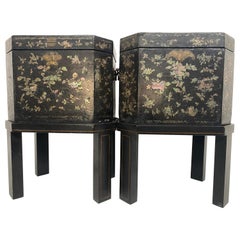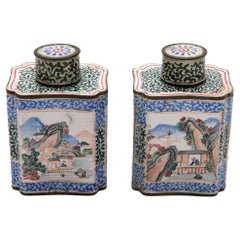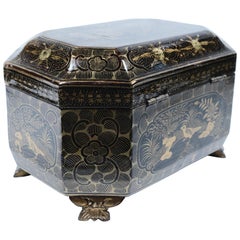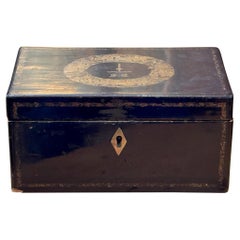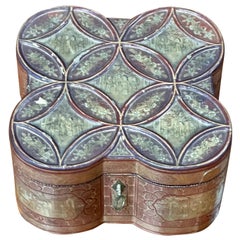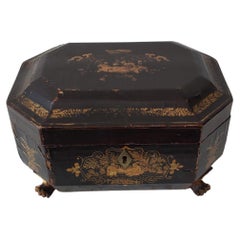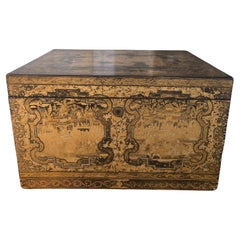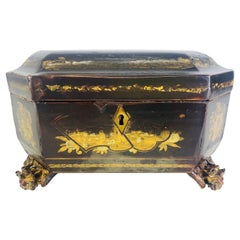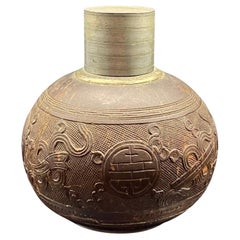Antique Chinese Tea Caddies
Mid-19th Century Chinese Qing Antique Chinese Tea Caddies
Lacquer
18th Century Chinese Other Antique Chinese Tea Caddies
Copper, Enamel
19th Century Chinese Antique Chinese Tea Caddies
Zinc
19th Century Chinese Antique Chinese Tea Caddies
Wood, Paint
19th Century Chinese Antique Chinese Tea Caddies
Lacquer
19th Century Chinese Qing Antique Chinese Tea Caddies
Pewter
1820s Chinese Qing Antique Chinese Tea Caddies
Lacquer
Mid-19th Century Chinese Chinese Export Antique Chinese Tea Caddies
Wood
19th Century Chinese Qing Antique Chinese Tea Caddies
Tin
Late 19th Century English Chinoiserie Antique Chinese Tea Caddies
Pewter
Early 20th Century Chinese Antique Chinese Tea Caddies
Wood, Lacquer
19th Century English Antique Chinese Tea Caddies
Mid-19th Century Chinese Chinese Export Antique Chinese Tea Caddies
Pewter
19th Century Regency Antique Chinese Tea Caddies
Wood
1770s Chinese Qing Antique Chinese Tea Caddies
Mother-of-Pearl
1890s Hong Kong Antique Chinese Tea Caddies
Silver
Late 19th Century Qing Antique Chinese Tea Caddies
Wood
1840s Chinese Chinese Export Antique Chinese Tea Caddies
Metal
Late 19th Century Chinese Antique Chinese Tea Caddies
Fabric
19th Century Regency Antique Chinese Tea Caddies
Wood
Mid-19th Century Chinese Antique Chinese Tea Caddies
Metal
Late 18th Century Chinese Chinese Export Antique Chinese Tea Caddies
Faience, Porcelain
Late 19th Century Chinese Antique Chinese Tea Caddies
Porcelain
1890s Chinese Chinese Export Antique Chinese Tea Caddies
Porcelain
17th Century Chinese Qing Antique Chinese Tea Caddies
Porcelain
18th Century Chinese Qing Antique Chinese Tea Caddies
Porcelain
17th Century Chinese Qing Antique Chinese Tea Caddies
Porcelain
Late 18th Century Asian Chinese Export Antique Chinese Tea Caddies
Early 20th Century Chinese Antique Chinese Tea Caddies
Late 19th Century Chinese Chinese Export Antique Chinese Tea Caddies
Wood
Late 19th Century Chinese Chinoiserie Antique Chinese Tea Caddies
Brass
Mid-19th Century Chinese Chinese Export Antique Chinese Tea Caddies
Mid-19th Century Chinese Antique Chinese Tea Caddies
Pewter
Early 19th Century Chinese Chinese Export Antique Chinese Tea Caddies
Lacquer
19th Century Chinese Antique Chinese Tea Caddies
Porcelain
18th Century German Chinoiserie Antique Chinese Tea Caddies
Gold, Sheet Metal
1920s Chinese Antique Chinese Tea Caddies
Steel
19th Century Chinese Regency Antique Chinese Tea Caddies
Brass
Early 20th Century Chinese Art Deco Antique Chinese Tea Caddies
Pewter
19th Century Chinese Antique Chinese Tea Caddies
Wood
1820s Chinese Chinese Export Antique Chinese Tea Caddies
19th Century Chinese Chinese Export Antique Chinese Tea Caddies
Pewter
19th Century Chinese Antique Chinese Tea Caddies
Pewter
19th Century Chinese Antique Chinese Tea Caddies
Tin
19th Century Chinese Antique Chinese Tea Caddies
Wood, Paint
Early 20th Century Chinese Chinese Export Antique Chinese Tea Caddies
Wood
19th Century Chinese Antique Chinese Tea Caddies
Silver
Mid-19th Century Chinese Chinese Export Antique Chinese Tea Caddies
Lacquer
Mid-19th Century Chinese Chinese Export Antique Chinese Tea Caddies
Lacquer
19th Century Chinese Antique Chinese Tea Caddies
19th Century Chinese Chinese Export Antique Chinese Tea Caddies
Paint
Late 18th Century Chinese Qing Antique Chinese Tea Caddies
Porcelain
19th Century Chinese Chinese Export Antique Chinese Tea Caddies
Silver
18th Century English Georgian Antique Chinese Tea Caddies
Sterling Silver
18th Century English Georgian Antique Chinese Tea Caddies
Sterling Silver
Mid-19th Century British Chinoiserie Antique Chinese Tea Caddies
Giltwood
18th Century Chinese Antique Chinese Tea Caddies
Porcelain
19th Century Chinese Chinese Export Antique Chinese Tea Caddies
Wood
Late 19th Century Chinese Chinese Export Antique Chinese Tea Caddies
Pewter
Early 20th Century Chinese Antique Chinese Tea Caddies
Porcelain
- 1
Antique Chinese Tea Caddies For Sale on 1stDibs
How Much are Antique Chinese Tea Caddies?
Finding the Right Tea-caddies for You
There are lots of uses for your vintage, new or antique tea caddies, but they can certainly serve their original intended purpose if needed.
When tea first gained popularity during the 1800s, and teatime became commonplace in homes all over England, it was an expensive commodity owing to excessive taxation. (This, of course, inevitably yielded a black market for tea leaves.) Tea drinkers hoarded their precious goods, which began to arrive in London ports from China during the 17th century, under lock and key. In luxury homes, tea leaves were stowed away in a decorative jar or canister called a tea caddy that was fitted with a lock, or, alternatively, the container was kept in a secured chest or storage cabinet.
Tea was thought to be not just a delicious drink but also to have medicinal benefits. The Chinese had been praising the healthy properties of tea, and wealthy Europeans were eager to discover its benefits for themselves during their ritual afternoon tea. The idea of “teatime” wasn’t a social event in upper-class British homes until the 1830s or 1840s. During Queen Victoria’s reign, small baked treats might be served with your beverage, and teakettles and coffeepots were part of tea services that could include teacups, saucers, a milk pot and other accessories.
When tea cultivation was relegated to British colonies such as India, and the British East India Company could no longer hold onto its trade monopoly with China, tea was no longer a ritual confined to the wealthy. Today, antique and vintage tea caddies are collector’s items all over the world.
Tea caddies weren’t unique to Europeans. The earliest pieces originated in China. Surviving hand-painted examples from China or elsewhere in Asia made of porcelain might feature enameled landscapes or other designs. At the Taft Museum of Art, there are striking enameled 18th-century-era tea caddies of copper that were given to the institution in 2014. Wooden tea caddies materialized over time and were seen as sturdier than their ceramic counterparts.
Today, there are all kinds of ways to use a vintage tea caddy if you’re passing on tea. They’re a welcome decorative flourish on the mantel in your living room, for example. A metal tea caddy, lined with a plastic bag, can be used to cultivate an herb garden on your kitchen windowsill. An old wooden tea caddy can help keep your paper clips or pushpins organized on your desk too. If you’re always on the go, a tea tin is good for packing earbuds, hand sanitizer, gum or whatever else that might get easily lost in a roomy crossbody messenger bag or other shoulder bag.
Teatime or not, find antique and vintage mid-century modern tea caddies, tortoiseshell caddies and more on 1stDibs.
Read More
Kazuyo Sejima’s Flowering Tree Blooms Year-Round
The brilliantly simple design turns a modest bouquet into a major statement.
He Wrote ‘Oedipus Rex,’ but Do You Know What He Looked Like?
The Greek tragedian is said to have been handsome in his day.
Cigar Culture Was Once the Peak of Masculinity. Now, It’s a Compelling Curiosity
Even for those who don’t indulge, elegant smoking accessories and audacious art portraying cigar enthusiasts hold a nostalgic allure.
African Travel Plans on Hold? This Ardmore Leopard Vase Brings the Beauty of the Savanna to You
It’s an excellent example of the sought-after ceramics coming out of South Africa’s KwaZulu-Natal province.
With a High-Tech Flagship and Cool Collabs, Lladró Is Breaking the Mold for Porcelain Production
Thanks to its new leadership, the Spanish maker of figurines, busts and lighting is on a mission to update the art of porcelain for the 21st century.
Zoë Powell’s Magnolia 05 Vessel Is Handmade from Clay She Unearthed Herself
The free-form stoneware piece is inspired by the magnolia tree and its associations with home.
8 Ways to Breathe New Life into a Space with Plants
The pair behind the Instagram account @houseplantclub share their tips for making any room of the house gloriously green.
Paris Gallerist Sandy Toupenet Gets Fired Up over 20th-Century Ceramics and Inventive New Makers
Her space on the city’s Left Bank mixes mid-century pieces by the likes of Jean Cocteau and Pablo Picasso with whimsical contemporary creations.
